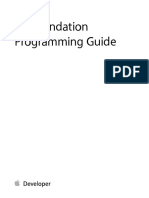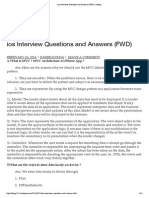Swift Cheatsheet
Uploaded by
Nivetha ArjunSamySwift Cheatsheet
Uploaded by
Nivetha ArjunSamySwift Cheat Sheet
Variables and Constants
/// You can change values with variables
var variable: DataType
/// Values of constants cannot be changed
let constant: DataType
Control Flow
If Statements
/// Use IF statements for simple conditions
/// with only a few possible outcomes
if condition {
// Runs the code here if condition is true
// Otherwise falls through the else conditionals
} else if anotherCondition {
// Runs the code if anotherCondition is true
} else {
// If none passed, runs the code here=
Switch Statements
/// Use SWITCH for more complex conditions
/// with multiple possible outcomes
switch someValue {
case outcome1:
// Respond to outcome1
case outcome2, outcome3:
// Respond to either outcome2 or outcome3
default:
// Otherwise, do something else
SwiftUI Cheatsheet 2023 © 2023. CodeWithChris.
PAGE 2 OF 5
Loops
For-in loop
/// Use for-in loops to iterate over a sequence
/// For in with arrays
let fruits = ["Apple", "Banana", "Coconut"]
for fruit in fruits {
print(fruit)
/// For in using the range operator
/// lower...upper
for variable in 1...10 { // 1 to 10
print(variable) // prints 1 to 10
/// lower..<upper
for variable in 0..<10 { // 0 to 9
print(variable) // prints 0 to 9
While loop
/// Use while loops to perform a set of code
/// until a condition becomes false
while conditionIsTrue {
doSomething()
}
var count = 0
while count < 2 {
print(count)
count += 1 // Increment count by 1
}
Repeat-While
/// Performs a single pass through the code
/// before considering the loop's condition
repeat {
doSomething()
} while conditionIsTrue
var count = 0
repeat {
print(count)
count += 1 // Increment count by 1
} while count < 2
SwiftUI Cheatsheet 2023 © 2023. CodeWithChris.
PAGE 3 OF 5
Operators
Arithmetic Operators
Operator Description
+ Addition
- Subtraction
* Multiplication
/ Division
1 + 2 // equals 3
2 - 1 // equals 1
1 * 2 // equals 2
5.0 / 2.5 // equals 2.0
Conditional Operators
Operator Description
== Equal to
!= Not equal to
> Greater than
< Less than
>= Greater than or equal to
<= Less than or equal to
a == b // Is `a` equal to `b`?
a != b // Is `a` not equal to `b`?
a > b // Is `a` greater than `b`?
a < b // Is `a` less than `b`?
SwiftUI Cheatsheet 2023 © 2023. CodeWithChris.
PAGE 4 OF 5
Nil-coalesing Operator
let defaultColor: Color = .red
var userPickedColor: Color? // defaults to nil
// Will default to `.red` if user didn't pick a Color
var colorToUse = userPickedColor ?? defaultColor
Range Operators
Operator Description
a...b Closed Range Operator
a..<b Half-open range Operator
1...10 // A range from 1 to 10
0..<10 // A range from 0 to 9
Declaring Types
Reference Types
Classes
/// Use classes if you want to pass objects by reference
/// or need features such as inheritance or type casting
class MyClass: SuperClass {
var storedProperty: Type
init(storedProperty: Type) {
self.storedProperty = storedProperty
SwiftUI Cheatsheet 2023 © 2023. CodeWithChris.
PAGE 5 OF 5
Declaring Types
Reference Types
Classes
/// Use classes if you want to pass objects by reference
/// or need features such as inheritance or type casting
class MyClass: SuperClass {
var storedProperty: Type
init(storedProperty: Type) {
self.storedProperty = storedProperty
Value Types
Structures
/// Use struct if you want to model data or pass objects
/// by value
struct Model {
var storedProperty: Type
Enumeration
/// Use enumeration to model a range of values
enum Compass {
case north, south, east, west
Protocols
protocol Printable {
var property: Type { get }
func print()
SwiftUI Cheatsheet 2023 © 2023. CodeWithChris.
You might also like
- Advanced IOS App Architecture Fourth Edition Raywenderlich Tutorial Team All Chapters Instant Download100% (4)Advanced IOS App Architecture Fourth Edition Raywenderlich Tutorial Team All Chapters Instant Download65 pages
- Cracking - iOS Interview - Questions NotesNo ratings yetCracking - iOS Interview - Questions Notes12 pages
- Combine - Asynchronous Programming With SwiftNo ratings yetCombine - Asynchronous Programming With Swift7 pages
- Game Development With Swift - Sample ChapterNo ratings yetGame Development With Swift - Sample Chapter24 pages
- Hacking With Swift Guide Book 2019-05-29 (PDF)No ratings yetHacking With Swift Guide Book 2019-05-29 (PDF)92 pages
- Combine Asynchronous Programming With Swift 2nd Edition Scott Gardner 2024 Scribd Download100% (1)Combine Asynchronous Programming With Swift 2nd Edition Scott Gardner 2024 Scribd Download79 pages
- Core Data by Tutorials iOS 8 and Swift Edition Aaron Douglas - Download the ebook and start exploring right away100% (1)Core Data by Tutorials iOS 8 and Swift Edition Aaron Douglas - Download the ebook and start exploring right away47 pages
- Preparing For A Technical IOS Job InterviewNo ratings yetPreparing For A Technical IOS Job Interview120 pages
- 3D Apple Games by Tutorials Learn How To Make 3D Games Using Swift 3 and SceneKit (Chris Language)100% (1)3D Apple Games by Tutorials Learn How To Make 3D Games Using Swift 3 and SceneKit (Chris Language)466 pages
- Instant Download Advanced Apple Debugging and Reverse Engineering Second Edition Derek Selander PDF All Chapters100% (2)Instant Download Advanced Apple Debugging and Reverse Engineering Second Edition Derek Selander PDF All Chapters65 pages
- Uplift IOS Interview - A Comprehensive Guide to Master Your IOS Interview (Ishtiak Ahmed) (Z-Library)No ratings yetUplift IOS Interview - A Comprehensive Guide to Master Your IOS Interview (Ishtiak Ahmed) (Z-Library)211 pages
- [FREE PDF sample] iOS Test Driven Development by Tutorials Second Edition By Joshua Greene & Michael Katz ebooks100% (1)[FREE PDF sample] iOS Test Driven Development by Tutorials Second Edition By Joshua Greene & Michael Katz ebooks50 pages
- iOS and macOS Performance Tuning 2017 3 PDFNo ratings yetiOS and macOS Performance Tuning 2017 3 PDF403 pages
- Test-Driven iOS Development With Swift - Sample ChapterNo ratings yetTest-Driven iOS Development With Swift - Sample Chapter18 pages
- Auto Layout PG (A Definitive Guide For IOS Programmers)No ratings yetAuto Layout PG (A Definitive Guide For IOS Programmers)30 pages
- Realm. Building Modern Swift Apps With Realm Database (2nd Edition) - 2019 (Todorov M.)No ratings yetRealm. Building Modern Swift Apps With Realm Database (2nd Edition) - 2019 (Todorov M.)301 pages
- Learning Swift Building Apps For Macos Ios and BeyondNo ratings yetLearning Swift Building Apps For Macos Ios and Beyond515 pages
- Download ebooks file Payment System Technologies and Functions Innovations and Developments 1st Edition Masashi Nakajima all chapters100% (3)Download ebooks file Payment System Technologies and Functions Innovations and Developments 1st Edition Masashi Nakajima all chapters81 pages
- The Swift Codebook: A Beginner's Guide from Basics to Best PracticesFrom EverandThe Swift Codebook: A Beginner's Guide from Basics to Best PracticesNo ratings yet
- Landing A Junior Developer JOB: The Beginner's Guide ToNo ratings yetLanding A Junior Developer JOB: The Beginner's Guide To24 pages
- All Interview Questions On Combine SwiftNo ratings yetAll Interview Questions On Combine Swift3 pages
- Introduction To Algorithms and Data Structures in Swift 4 Get Ready For Programming Job Interviews. Write Better, Faster Swift Code. (Swift Clinic Book 1) - Karoly NyisztorNo ratings yetIntroduction To Algorithms and Data Structures in Swift 4 Get Ready For Programming Job Interviews. Write Better, Faster Swift Code. (Swift Clinic Book 1) - Karoly Nyisztor182 pages
- SwiftUI Animations Mastery (Mark Moeykens) (Z-Library)No ratings yetSwiftUI Animations Mastery (Mark Moeykens) (Z-Library)475 pages
- [2019] Design Patterns by Tutorials - Learning Design Patterns in Swift, 3rd EditionNo ratings yet[2019] Design Patterns by Tutorials - Learning Design Patterns in Swift, 3rd Edition372 pages
- Xcode Cheat Sheet: Search Navigation EditingNo ratings yetXcode Cheat Sheet: Search Navigation Editing2 pages
- Swift 2 Design Patterns: Build robust and scalable iOS and Mac OS X game applicationsFrom EverandSwift 2 Design Patterns: Build robust and scalable iOS and Mac OS X game applicationsNo ratings yet
- Buck - Cocoa Design Patterns For BeginnersNo ratings yetBuck - Cocoa Design Patterns For Beginners30 pages
- 158955https://sites Google Com/view/money-Robot1No ratings yet158955https://sites Google Com/view/money-Robot12 pages
- Technical Tip - Initial Troubleshooting For GUI or ... - Fortinet CommunityNo ratings yetTechnical Tip - Initial Troubleshooting For GUI or ... - Fortinet Community5 pages
- Data Mining - Practical Machine Learning Tools AndTechniques With Java ImplementationsNo ratings yetData Mining - Practical Machine Learning Tools AndTechniques With Java Implementations3 pages
- Development of Wi-Fi Communication Module For Atmega Microcontroller Based Mobile Robot For Cooperative Autonomous NavigationNo ratings yetDevelopment of Wi-Fi Communication Module For Atmega Microcontroller Based Mobile Robot For Cooperative Autonomous Navigation5 pages
- An Analytical Model For A GPU Architecture With Memory-Level and Thread-Level Parallelism AwarenessNo ratings yetAn Analytical Model For A GPU Architecture With Memory-Level and Thread-Level Parallelism Awareness12 pages
- Draft Filsfils Spring srv6 Network Programming 07No ratings yetDraft Filsfils Spring srv6 Network Programming 0742 pages
- Smart Homes Automation System Using Cloud Computing Based Enhancement SecurityNo ratings yetSmart Homes Automation System Using Cloud Computing Based Enhancement Security6 pages
- Detecting Fake News by RNN-based Gatekeeping Behavior Model on Social NetworksNo ratings yetDetecting Fake News by RNN-based Gatekeeping Behavior Model on Social Networks13 pages
- CentOS 6 - DNS Server - Install - Configure BIND - Server WorldNo ratings yetCentOS 6 - DNS Server - Install - Configure BIND - Server World3 pages
- Advanced IOS App Architecture Fourth Edition Raywenderlich Tutorial Team All Chapters Instant DownloadAdvanced IOS App Architecture Fourth Edition Raywenderlich Tutorial Team All Chapters Instant Download
- Combine Asynchronous Programming With Swift 2nd Edition Scott Gardner 2024 Scribd DownloadCombine Asynchronous Programming With Swift 2nd Edition Scott Gardner 2024 Scribd Download
- Core Data by Tutorials iOS 8 and Swift Edition Aaron Douglas - Download the ebook and start exploring right awayCore Data by Tutorials iOS 8 and Swift Edition Aaron Douglas - Download the ebook and start exploring right away
- 3D Apple Games by Tutorials Learn How To Make 3D Games Using Swift 3 and SceneKit (Chris Language)3D Apple Games by Tutorials Learn How To Make 3D Games Using Swift 3 and SceneKit (Chris Language)
- Instant Download Advanced Apple Debugging and Reverse Engineering Second Edition Derek Selander PDF All ChaptersInstant Download Advanced Apple Debugging and Reverse Engineering Second Edition Derek Selander PDF All Chapters
- Uplift IOS Interview - A Comprehensive Guide to Master Your IOS Interview (Ishtiak Ahmed) (Z-Library)Uplift IOS Interview - A Comprehensive Guide to Master Your IOS Interview (Ishtiak Ahmed) (Z-Library)
- [FREE PDF sample] iOS Test Driven Development by Tutorials Second Edition By Joshua Greene & Michael Katz ebooks[FREE PDF sample] iOS Test Driven Development by Tutorials Second Edition By Joshua Greene & Michael Katz ebooks
- Test-Driven iOS Development With Swift - Sample ChapterTest-Driven iOS Development With Swift - Sample Chapter
- Auto Layout PG (A Definitive Guide For IOS Programmers)Auto Layout PG (A Definitive Guide For IOS Programmers)
- Realm. Building Modern Swift Apps With Realm Database (2nd Edition) - 2019 (Todorov M.)Realm. Building Modern Swift Apps With Realm Database (2nd Edition) - 2019 (Todorov M.)
- Learning Swift Building Apps For Macos Ios and BeyondLearning Swift Building Apps For Macos Ios and Beyond
- Download ebooks file Payment System Technologies and Functions Innovations and Developments 1st Edition Masashi Nakajima all chaptersDownload ebooks file Payment System Technologies and Functions Innovations and Developments 1st Edition Masashi Nakajima all chapters
- The Swift Codebook: A Beginner's Guide from Basics to Best PracticesFrom EverandThe Swift Codebook: A Beginner's Guide from Basics to Best Practices
- Landing A Junior Developer JOB: The Beginner's Guide ToLanding A Junior Developer JOB: The Beginner's Guide To
- Introduction To Algorithms and Data Structures in Swift 4 Get Ready For Programming Job Interviews. Write Better, Faster Swift Code. (Swift Clinic Book 1) - Karoly NyisztorIntroduction To Algorithms and Data Structures in Swift 4 Get Ready For Programming Job Interviews. Write Better, Faster Swift Code. (Swift Clinic Book 1) - Karoly Nyisztor
- SwiftUI Animations Mastery (Mark Moeykens) (Z-Library)SwiftUI Animations Mastery (Mark Moeykens) (Z-Library)
- [2019] Design Patterns by Tutorials - Learning Design Patterns in Swift, 3rd Edition[2019] Design Patterns by Tutorials - Learning Design Patterns in Swift, 3rd Edition
- Swift 2 Design Patterns: Build robust and scalable iOS and Mac OS X game applicationsFrom EverandSwift 2 Design Patterns: Build robust and scalable iOS and Mac OS X game applications
- Technical Tip - Initial Troubleshooting For GUI or ... - Fortinet CommunityTechnical Tip - Initial Troubleshooting For GUI or ... - Fortinet Community
- Data Mining - Practical Machine Learning Tools AndTechniques With Java ImplementationsData Mining - Practical Machine Learning Tools AndTechniques With Java Implementations
- Development of Wi-Fi Communication Module For Atmega Microcontroller Based Mobile Robot For Cooperative Autonomous NavigationDevelopment of Wi-Fi Communication Module For Atmega Microcontroller Based Mobile Robot For Cooperative Autonomous Navigation
- An Analytical Model For A GPU Architecture With Memory-Level and Thread-Level Parallelism AwarenessAn Analytical Model For A GPU Architecture With Memory-Level and Thread-Level Parallelism Awareness
- Smart Homes Automation System Using Cloud Computing Based Enhancement SecuritySmart Homes Automation System Using Cloud Computing Based Enhancement Security
- Detecting Fake News by RNN-based Gatekeeping Behavior Model on Social NetworksDetecting Fake News by RNN-based Gatekeeping Behavior Model on Social Networks
- CentOS 6 - DNS Server - Install - Configure BIND - Server WorldCentOS 6 - DNS Server - Install - Configure BIND - Server World

























































































